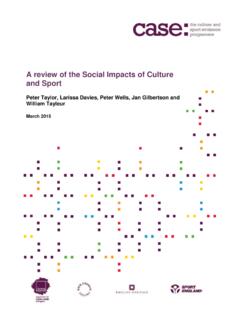Transcription of The Improving Access to Psychological Therapies (IAPT ...
1 The Improving Access to Psychological Therapies (IAPT). Pathway for People with Long-term Physical health Conditions and Medically Unexplained Symptoms NHS England and NHS Improvement Publications Gateway Reference: 07781 Version: 1. Document purpose: To provide guidance on the IAPT-LTC pathway Publication date: 21st March 2018. Target audience: Mental health commissioners, physical health commissioners, IAPT providers Additional Clinical networks circulation list: Description: From April 2018 all CCGs are expected to expand IAPT by commissioning IAPT. services integrated into physical healthcare pathways. This document supports this expansion by setting out the treatment pathway that underpins the Access and waiting time standards, which all services should seek to measure themselves against. The guidance also provides evidence on what works, as well as local case studies of service-led examples that describe how to make IAPT-LTC services a reality Contact details for Mental health Policy and strategy Team further information: Skipton House 80 London Road London SE1 6LH.
2 Equality and health Inequalities Statement Promoting equality and addressing health inequalities are at the heart of NHS England's values. Throughout the development of the policies and processes cited in this document, we have: Given due regard to the need to eliminate discrimination, harassment and victimisation, to advance equality of opportunity, and to foster good relations between people who share a relevant protected characteristic (as cited under the Equality Act 2010) and those who do not share it; and Given regard to the need to reduce inequalities between patients in, Access to, and outcomes from healthcare services and to ensure services are provided in an integrated way where this might reduce health inequalities. The IAPT Pathway for People with Long-term Physical health Conditions and Medically Unexplained Symptoms Contents 1.
3 Aims of this document 4. 2. Policy and strategic context 6. 3. Delivering IAPT-LTC services 9. 4. The IAPT-LTC pathway 10. 5. Key commissioning considerations 13. 3. The IAPT Pathway for People with Long-term Physical health Conditions and Medically Unexplained Symptoms The pathway values statement This guidance represents a commitment to ensuring that mental health care is delivered in a person- centred, compassionate and supportive way, promoting safety and wellbeing at the forefront. Mental health service provision should be needs-led, outcome-focused, responsive and delivered in a way that empowers people to build on their strengths, promotes recovery, supports families and carers, and ensures equality and fairness for all. 1. Aims of this document This pathway has been developed by the About IAPT services for people with LTCs National Collaborating Centre for Mental and MUS.
4 health , following a process agreed with the National Institute for health and Care IAPT services are transforming the treatment of Excellence (NICE), with support from an depression and anxiety disorders in England. Now Expert Reference Group including experts by established in every clinical commissioning group experience, carers, practitioners, academics, commissioners, service managers and (CCG), IAPT services provide a course of NICE- representatives from national NHS arm's- recommended Psychological therapy to over half length bodies. a million people each year. A unique session-by- session monitoring system collects outcome data For more detailed discussion, evidence, from almost every person. Nationally, one in two step-by-step pathways and positive practice people recover and one in three show significant examples for all aspects of the IAPT pathway improvement in their mental health .
5 For people with long-term physical health conditions (LTCs) and medically unexplained Around 40% of people with depression and symptoms (MUS) see the full implementation anxiety disorders also have an LTC. Around 30%. guidance, published by the National Collaborating Centre for Mental health . of people with an LTC and 70% with MUS also have mental health comorbidities. Currently, mental and physical health care are provided by separate services that are rarely coordinated. This is inconvenient for the person, costly to the NHS. and likely to produce sub-optimal outcomes. Building on IAPT's existing dedicated workforce, development of new IAPT services for people with LTCs and MUS is underway (called IAPT- LTC' services for short in this guidance). These services will aim to ensure that people with LTCs and MUS have the same Access to NICE- recommended Psychological Therapies as other people.
6 They will bring together mental and physical health providers so they can work in a coordinated way to achieve the best outcomes for all people, irrespective of their diagnosis. 4. The IAPT Pathway for People with Long-term Physical health Conditions and Medically Unexplained Symptoms This guidance sets out the policy initiatives Addressing inequalities in Access and and strategic context for the national expansion of experience of mental health services was set out as IAPT services for adults (aged 18 years to the end a priority in The Five Year Forward View for Mental of life) with LTCs and MUS. The expansion is a health . Local commissioners should be able to key priority for commissioners, providers and demonstrate the way they meet the duties placed Sustainability and Transformation Partnerships (STPs) on them under the Equality Act 2010 and the as it is one of the mental health objectives outlined health and Social Care Act 2012.
7 Services should be in the Next Steps on the NHS Five Year Forward designed to meet the needs of diverse communities, View, published in March 2017. be accessible to them and be able to communicate with them effectively. The full implementation The guidance supports this expansion by guidance outlines the steps that commissioners can setting out the treatment pathway that underpins take to do this. the Access and waiting time standards, which all services should seek to measure themselves against. Local service design should be co-produced The guidance also provides evidence on what works, to meet the needs of the local population and as well as local case studies of service-led examples tailored to people's personal circumstances. Services that describe how to make IAPT-LTC services a should consider culturally specific beliefs, needs and reality.
8 Values, as well as providing support for families and carers of people with mental health needs. 5. The IAPT Pathway for People with Long-term Physical health Conditions and Medically Unexplained Symptoms 2. Policy and strategic context We should have fewer cases where people are unable to get physical care due to mental health problems affecting engagement and attendance (and vice versa). And we need [the] provision of mental health support in physical health care settings especially in primary care.. The Five Year Forward View for Mental health The Five Year Forward View for Mental Healthcare costs for those with coexisting health and the Next Steps on the NHS Five Year mental and physical health problems, compared Forward View highlighted the disparity between with costs for physical health problems alone, mental and physical health care.
9 Are also significantly higher (around 50%). A. large proportion of this cost is accounted for by Mental and physical health are intrinsically increased use of physical health services (not mental linked, and the relationship between untreated health services). This includes a higher number of depression and anxiety disorders and poor physical primary and secondary care consultations, as well health is complex and bi-directional (see Section 2 as increased rates of hospitalisation and repeat of the full implementation guidance for further attendance. detail). If left untreated, mental health problems can have a significant impact on the person's physical health . This includes: lowering the person's likelihood of engaging with the treatment of their physical health problem and reducing their ability to self- manage effectively increasing the person's likelihood of unhealthy behaviours, such as smoking and poor diet worsening the person's physical health , including premature mortality poorer employment outcomes, including a higher risk of absenteeism and unemployment.
10 6. The IAPT Pathway for People with Long-term Physical health Conditions and Medically Unexplained Symptoms Working with the wider system The expansion of IAPT is part of a wider move towards integrating mental and physical health across the healthcare system. IAPT-LTC services should be developed alongside existing services, with clear arrangements for joint working. Key partners include: Liaison mental health services (including core 24), sometimes called integrated Psychological medicine', which provide care in general hospital emergency departments, inpatient units and outpatient clinics (see the urgent and emergency liaison mental health care pathway for adults and older adults). Clinical and health psychology services, which work as part of healthcare teams within general hospitals and may form an integral part of the IAPT-LTC workforce Integrated primary and acute care systems (PACS) vanguards, which aim to improve physical, mental and social health and wellbeing , and reduce inequalities, with general practice at their core Specialist physical health services, such as pain or sleep disorder services, which may be based in either inpatient or community settings.
















